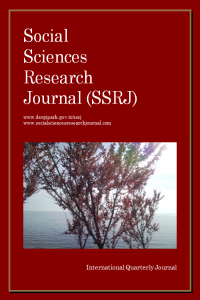Eğitimde Bencillik Ölçeğinin Geliştirilmesi: Geçerlilik ve Güvenilirlik Çalışması
Bencillik, Eğitimde Bencillik, , Geçerlilik, Güvenirlik
Development of the Selfishness Scale in Educatıon Validity And Reliability Study
Selfishness, Selfishness in Education, , Validity, Reliability,
___
- Agarwall, J. and Malloy, D.C. (1999). Ethical Work Climate Dimensions In a Not-For Profit Organization: An Emprical Study, Journal of Business Ethics, 20, 1- 14.Altunışık, R., Çoşkun, R., Bayraktaroğlu, S. ve Yıldırım, E. (2012). Sosyal Bilimlerde Araştırma Yöntemleri Spss Uygulamalı, Sakarya Yayıncılık.Batson, D. C. (2014). The Altruism Question: Toward a Social-Psychological Answer, Howe, England: Psychology Press.Brown, T. A. (2015). Confirmatory Factor Analysis for Applied Research, New York: The Guilford Press.Cevizci, A. (2008). Etiğe Giriş, İstanbul: Paradigma Yayıncılık.Christensen, M. M. (2015). God, Adam, and You, U.S.A.: Wipf & Stock.Crowley, S. L. and Fan, X. (1997). Structural Equation Modeling: Basic Concepts and Applications in Personality Assessment Research. Journal of Personality Assessment, 68 (3), 508-31.Cullen, J. B., Parboteeah, P, K. and Victor, B. (2003). The Effects of Ethical Climates on Organisational Commitment: A Two-Study Analysis, Journal of Business Ethics, 46 (2), 127–141.Cullen, J. B., Victor, B. and Bronson, J. W. (1993). The Ethical Climate Questionnaire: on Assessment of its Development and Validity, Psychological Reports, Vol 73(2), 667-674.Exley, C. L. (2016). Excusing Selfishness in Charitable Giving: The role of risk. Review of Economic Studies, 83 (2), 587–628.Frankena, W. ( 2007). Etik, (Çeviren: A. Aydın.), Ankara: İmge Yayınevi.Fromm, E. (1995), Bütün Eserleri 2, (Çeviren: A Arıtan), Arıtan Yayıncılık: İstanbul.Gren, K. E. M., Jacobi, D. and Hall, C. L. (1993). The Effects of Two Types of Appeal on Survey Response Rates, Annual Meeting of the American Educational Research Association, 1-16.Hayes, D. (2004). Recruitment and Retention: Insights into The Motivation of Primary Trainee Teachers in England. Research in Education, 71, 37-49.Henson, R. K. and Roberts, J. K. (2006). Use of Exploratory Factor Analysis in Published Research: Common Errors and Some Comment on İmproved Practice. Educational and Psychological Measurement, 66 (3), 393-416.Hooper, D., Coughlan, J. and Mullen, M. (2008). Structural Equation Modelling: Guidelines For Determining Model Fit. Electronic Journal of Business Research Methods, 6 (1), 53-60.Hu, L.T. and Bentler, P. M. (1999). Cut-Off Criteria for Fit İndexes in Covariance Structure Analysis: Conventional Criteria Versus New Alternatives. Structural Equation Modeling, 6, 1-55.İzveren, A. (1980). Toplumsal Törebilim, Sosyal Ahlak, Ankara İktisadi ve Ticari İlimler Akademisi Yayını: Ankara.Kline, R. B. (2016). Principle And Practice of Structural Equation Modelling, New York, NY: The Guilford Press.Loo, R. (2002). Tackling Ethical Dilemmas in Project Management Using Vignettes, International Journal of Project Management, 20 (7), 489-95.Martin, K. D. ve Cullen, J. B. (2006). Continuities and Extensions of Ethical Climate Theory: A Meta-Analytic Review, Journal of Business Ethics, 69 (2), 175–194.Newman, G. E. and Cain, D. M. (2014). Tainted Altruism: When Doing Some Good Is Evaluated as Worse Than Doing No Good at All, Psychological Science, 25(3), 648-655.Özlem, D. ( 2010). Etik-Ahlak Felsefesi, İstanbul: Say Yayınları.Rummel, R. J. (1988). Applied Factor Analysis. Illinois Evanston: Northwestern University Press.Steiger, J. H. (2007). Understanding the Limitations of Global fit Assessment in Structural Equation Modeling. Personality and Individual Differences, 42(5), 893-98.Sümer, N. (2000). Yapısal Eşitlik Modelleri: Temel Kavramlar ve Örnek Uygulamalar, Türk Psikoloji Yazıları, 3(6), 49–74.Topses, G. (2012). Elseverlik (Alturizm) ve Benseverlik (Egoizm) Ölçeğiyle İlgili Geçerlik ve Güvenirlik Çalışması, International Journal of New Trends in Arts, Sports & Science Education, (1),2, 60-71.Victor, B. and Cullen, J. B. (1988). The Organisational Bases of Ethical Work Climates, Administrative Science Quarterly, 33, 101–125.Worthington, R. L. and Whittaker, T. A. (2006). Scale Development Research: A Content Analysis and Recommendations for Best Practices. The Counseling Psychologist, 34(6), 806-838.Yılmaz, H. (2018). Bencillik Ölçeği: Bencilliğin Uyumsal, Egosantrik ve Patolojik Biçimlerinin Ölçülmesi, Akademik Sosyal Araştırmalar Dergisi, (6),74, 45-57. Yong, A. G. and Pearce, S. (2013). A Beginner’s Guide to Factor Analysis: Focusing on Exploratory Factor Analysis, Tutorials in Quantitative Methods for Psychology, 9 (2), 79-94.
- Yayın Aralığı: Yılda 4 Sayı
- Yayıncı: Denta Florya ADSM Limited Company
Sanal Para Piyasası ve Türkiye Ekonomisine Entegrasyonu
Şahin KARATEKİN, Meltem OKUR DİNÇSOY
Mâturidî’nin Te’vîlâtu’l-Kur’ân’ı Temelinde Kur’ânî Bir Kavram Olarak “Tatavvu”
Determinants of the Short-Run Interest Rate in Turkey: A Taylor Rule Approach
Investigation of the Sustainability Index in Developing Countries and Turkey Size
Azerbaycan'ın Enerji Stratejisi
Performance Analysis of Foreign Deposit Banks in Turkey: A Multi-Moora Method
Toplumsal Cinsiyet Rol Algıları ve Kariyer Seçimi İlişkisi: Kafkas Üniversitesinde Bir Araştırma
